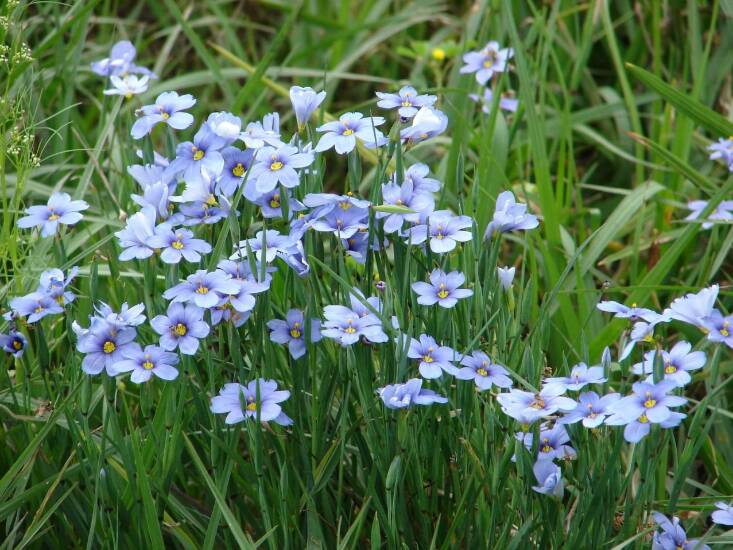Blue-Eyed Grass, Sisyrinchium spp.
While I have been swapping out non-natives for natives in my garden for years, blue-eyed grass was not on my radar until a few years ago. I found it in my backyard. I did not plant it. Which made it all the more enthralling. This barely eight-inch-tall plant has the most beautiful, tiny violet-blue flowers with bright yellow centers. My guess is that its common name comes from the blue petals surrounding the yellow center like our irises surround our pupils. I have since gone on to order plugs every fall from my local native plant nursery. I want more in my yard!
Above: A young Sisyrinchium angustifolium ‘Lucerne’ in my garden. Photograph by Joy Yagid.
Blue-eyed grass, Sisyrinchium spp. is a native perennial in both North and South America. However, it is not actually a grass. It is in the iris family. Once you learn this, you can’t help but see the resemblance. The fan-like spread of its sword-shaped leaves resemble a miniature iris. Its star-shaped five-petaled flowers can range from white, pale blue, blue, violet blue, to a purple. Most have yellow centers. There is one South American variety, S. striatum (pale yellow-eyed grass), that has yellow flowers.
Cheat Sheet
 Above: Different shades of violet. Photograph by Greg Peterson via Flickr.
Above: Different shades of violet. Photograph by Greg Peterson via Flickr.
- Blue-eyed grass is a perennial that grows to 6” to 24” tall, depending on the variety. Most will form dense clumps and most have flowers that are less than an inch across.
- Many varieties are hardy in zones 4 to 8, with some hardy to zone 5 to 9. Prairie blue-eyed grass, S. campestre, hardy in zones 2 to 9, has the widest range. The most common variety, S. angustifolium, including ‘Lucerne’, is hardy in zones 4 to 9.
- Depending on the variety, it can bloom from March to July. The flowers last only one day (like morning glories and daylilies) and there are one to two per flower stalk.
- There is a wide variety of blue-eyed grasses to choose from: S. mucronatum grows up to 16” tall and is happy on the East Coast of the U.S.; S. albidum, white blue-eyed grass, grows well in open fields and woods; S. idahoense flowers in the West and prefers sandy moist soils: S. montanum is found mostly in the northern U.S.
Keep It Alive
 Above: Blue-eyed Grass Photograph by K. Draper via Wild Cherry Farm.
Above: Blue-eyed Grass Photograph by K. Draper via Wild Cherry Farm.
- Prefers full sun. Can tolerate some shade but will bloom less.
- Needs to be watered during dry spells and droughts. Prefers moist well-draining soils.
- The preferred soil type is poorer quality soils, but it depends on the variety and can range from sandy, loam, rich in organic matter, and clay.
- Plant the crown of the plant at soil level.
- Does not need to be fertilized and should not be mulched. Mulching can cause crown rot.
- Divide every two to three years by splitting the crown.
- Deer-resistant, disease- and pest-free when its needs are met.
For more perennials with petite blue flowers, see:



